Chaos and Hope in the Land Beyond the Drug War
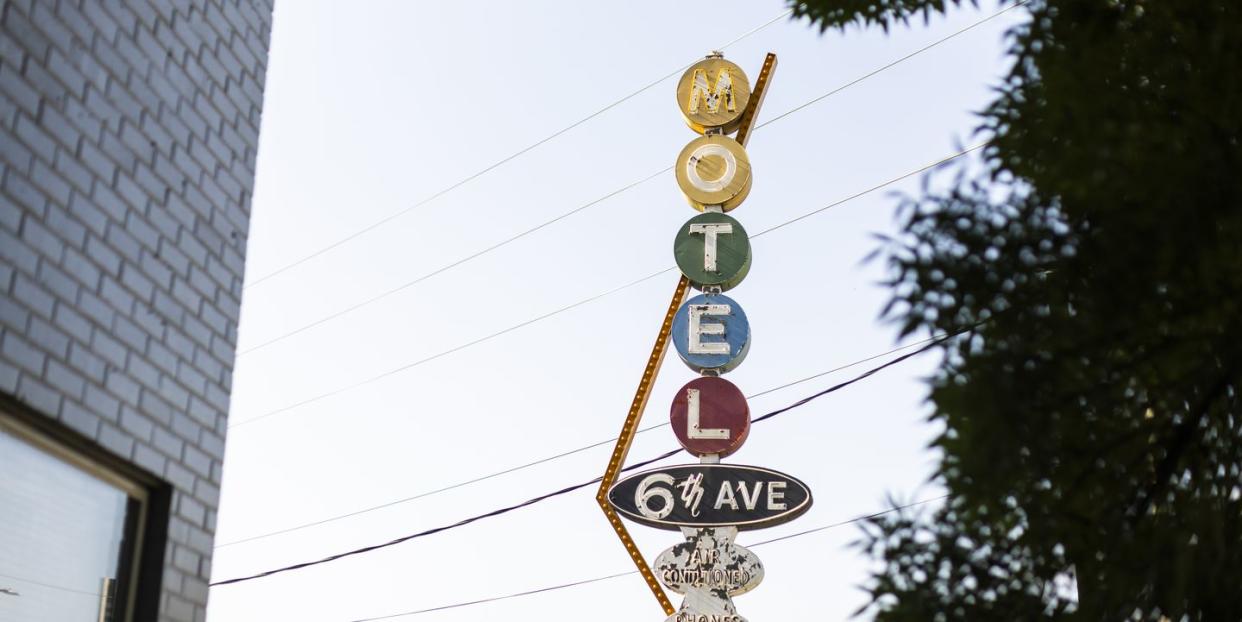
Down a side street parallel to Eighty-second Avenue in Southeast Portland, a gangly young white guy in a T-shirt and jeans stood on the sidewalk with one foot on the pedal of a galaxy-purple bike. His name was Brandon, and there were two red marks on his face that he said were from a fall. He’d bought the bike from a junkie for five dollars. “People are fiends out here,” he said. Then, with some half regret: “That’s terrible.”
It was a 90 degree day in June, and the sun beat down mercilessly on the block. I’d come here with Justine Pope and Morgan Godvin, two friends who work in different corners of the drug-treatment world, to talk to some people living outside. Shopping carts and debris lined one side of the street, and tarps were hung over whatever was handy, wood planks or sturdy plastics, whatever would create a facsimile of a tent. Across the road, there were single-family homes with front yards and concrete paths to the doors, nothing special but solid. As we got closer to the crowd on the houseless side, the sound grew from a portable speaker toted by a middle-aged Black man with a knife in a sheath hanging prominently down his leg from a waist belt.
Fentanyl changed everything, Brandon told us. “I remember in the beginning, when it first started, it was super strong—up and down,” he said. “People were dyin’ like a motherfucker.” Fentanyl powder is cropping up more and more, and Brandon mentioned his brother was injecting it for a stint. He thought that was crazy. Methamphetamine use has grown in tandem with opiates in the Northwest since 2019, according to urinalysis data from Millennium Health, a lab that as of late 2022 found that close to 60 percent of people coming up for fent in Oregon also test positive for meth.
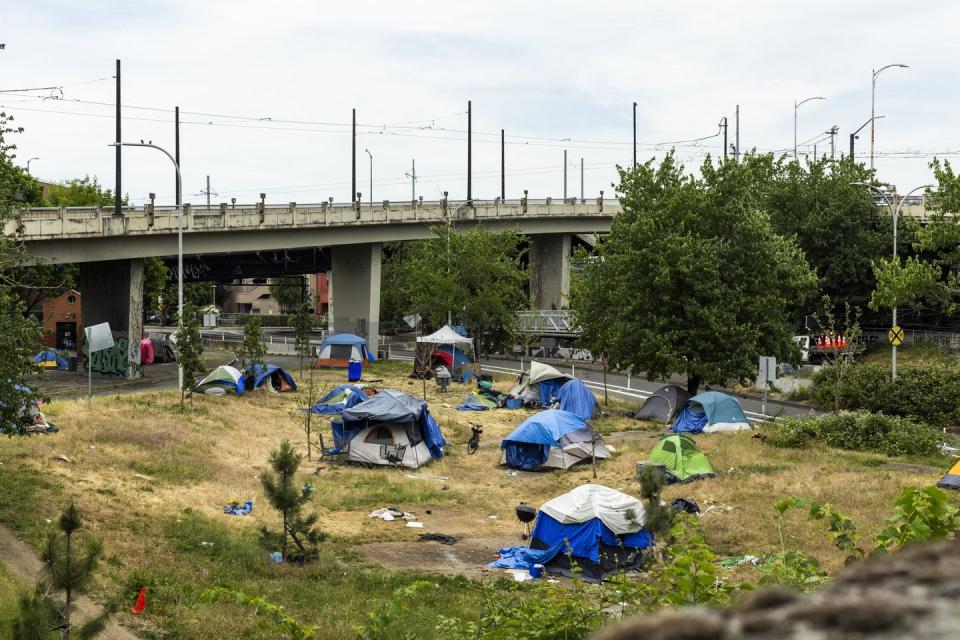
Every state and every town in this country has a fentanyl problem, because for distributors, fentanyl is one hell of a product. It’s potent—up to fifty times stronger than heroin—so they can pack more highs per square inch into the back of a truck. It’s cooked up in a lab with synthetic materials, so there are none of the agricultural headaches of opium poppies. All this makes fentanyl cheap and dangerous because the syndicates manufacturing it on an industrial scale south of the border aren’t pharmaceutical companies, and they’re creating highly inconsistent batches, sometimes pill to pill. One might be an 8 out of 10, another a 4, and they’re often pressed blue with “M30” on the side to look like oxycodone (though few are under the illusion they’re using anything other than fent). People have been dying all over, from West Virginia to Maine to New Mexico. It’s more than fifty years on from our declaration of a war on narcotics, and people are getting higher on more destructive shit than ever.
There is one place in America, however, that’s decided to do things differently. Among the fifty states, only Oregon has decriminalized simple possession of all drugs through Measure 110, a ballot initiative voters approved in November 2020 that also took most of the tax proceeds from the state’s legal marijuana sales and put it toward treatment for more-serious substance use. So far, around $300 million has gone out to groups across Oregon’s thirty-six counties, though a May report found the state has also saved $37 million it could have spent putting drug users through the criminal-justice system. It is the first jurisdiction in the United States to follow Portugal’s lead in treating drug abuse as a behavioral-health disorder, not a crime. So I went out to Portland, and to a rural county near Oregon’s flagship city, to see where all that money is going and what the work of healing people really looks like.
“This was black tar heroin’s last stand,” Morgan told me, referring to the I-5 corridor from Washington to California. These days, she sits on the Oversight and Accountability Council for Measure 110, but years ago she was deep into heroin herself. She was in and out of jail for a long time, including four years on a federal charge when she was held responsible for her friend’s overdose death, but going to prison over and over never did much to stop her using. She was shocked at what she found in Portland when she got out in 2018, as a longtime housing shortage gave way to an explosion of tent cities. Then the state saw a surge in heroin and prescription-opioid use in 2019 and 2020, the culmination of a shift in which Portland’s beaming openness to the world began to fade toward something darker. Then the fentanyl flooded in, and now everything is fentanyl. It has almost completely replaced heroin on the street. A serviceable amount costs three dollars.
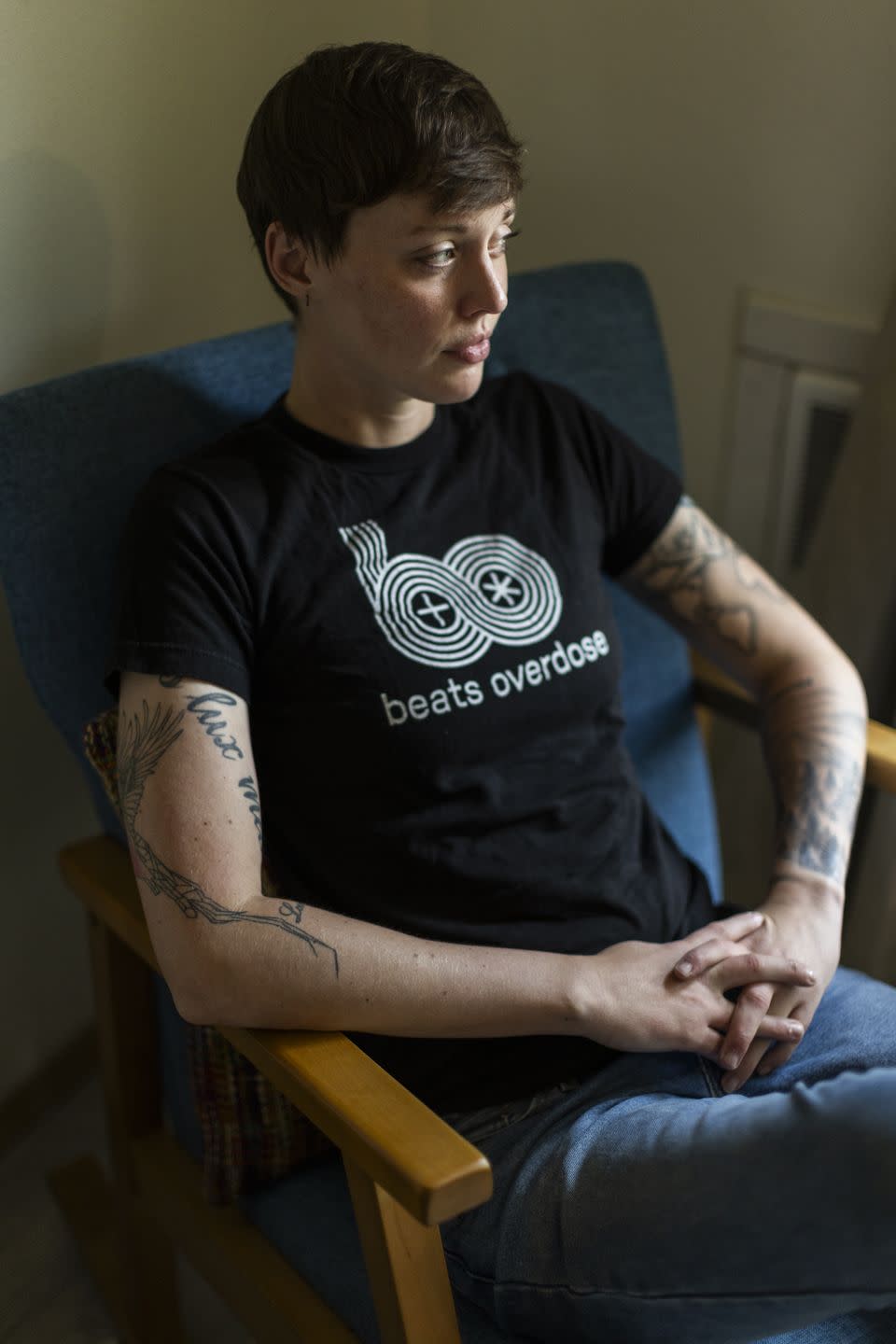
Up the block, Morgan introduced me to a young white guy named Damon and his girlfriend, “Red,” for her hair that was tied up in a tilting bun. She wore a black lace bra under a white tank. Behind them was a chain-link fence. Off to their right, there were a couple of shopping carts filled with supplies. They’d been out here a year and a half. Damon wanted gig work, odd jobs, but he struggled to find them. He and Red felt people hated them just for the sight of them existing nearby. Everybody thought they were waiting to steal something. “A lot of the homeless people out here, they just don’t give a fuck,” Red said. “They don’t have self-respect. Which I can understand. But we’re not like that. People just see us as, like, ‘This bum,’ and I’m not a bum.” She was almost pleading on the last words, a sob escaping for less than a moment.
They’d both come up from California, but not together. He was thirty-seven, and she was twenty-three. Justine said he looked good, and Damon did look young and fairly healthy for someone on a steady diet of fentanyl and meth. Red’s pale face had the telltale markings of the latter. She’d kept taking care of her hair and her clothes just to stay sane. She said he’d owned a contracting business and sold it for a chunk of cash and worked for the company that bought him out. She was “doing [her] little thing in retail.” But they both lost their jobs during Covid, and sitting around the house led to using, which led, eventually, to not having a house. “It—was a lot,” she said, choking on the words.
As we moved down the block, we said thanks to Damon, who asked our names again. “Jack and Justine. Have a good day, guys.”
“We weren’t forced out here,” Brandon said, still half perched on his bike. “Some were, I guess, but there was something that obviously happened, that they did, and this is their consequence. ‘Woe is me,’ that’s fucked up to say. I can’t sit here and say, ‘Oh, this is all because of the laws.’ It’s not. It’s ’cause I fucked up.” He said he’d been out here two weeks—“A quick little window. It doesn’t scare me. I’m all about experiences.”—and that there should be folks coming by every day to talk to people living on the street. Not to bring stuff, though. “There’s people that bring food—it’s just enabling,” he said. “It’s just food. That’s all you bring.”
Brandon is describing an approach called “harm reduction,” in which outreach begins with offering people help with what they need to survive where they are: water; a sandwich; Narcan, the nasal spray that can stop you from dying in an opioid overdose. Some people doing this work believe it means giving someone a tarp to live under. Morgan thinks housing is vital, that no treatment is likely to take if you’re going home to a tent at night. She and Justine are both harm reductionists, but they (lightly) mocked the people who come by on weekends, hand out some stuff, and that’s the end of it. The true harm reductionists know that the material aid is about establishing a connection, planting a seed that you have to go back to the garden and tend to week after week until someone starts to believe for the first time in however long that somebody cares what happens to them, that maybe they should care, that they can’t just keep saying none of this shit matters so why not keeping getting high.
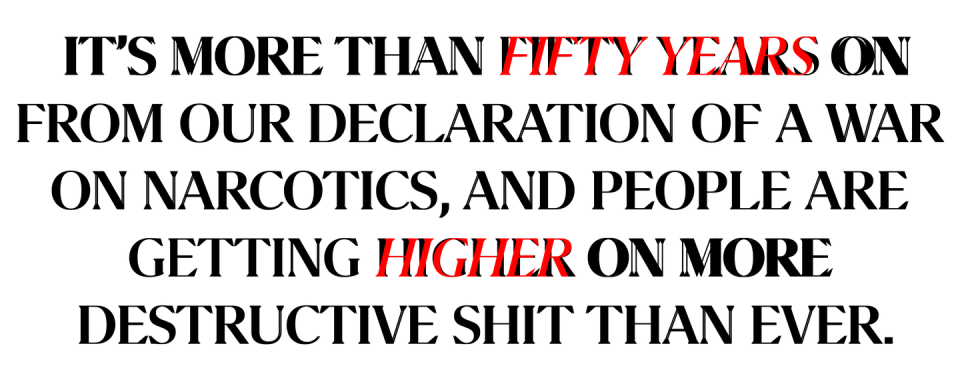
“What do you really need?” Morgan asked Brandon, twice.
While we spoke, Justine and Red went over to the curb on the far sidewalk and sat there. They stretched their legs out into the street, chatting. Damon went with another guy to sit on the curb a bit further down and smoke something.
“Maybe somebody to confide in,” Brandon said. He said he’d gotten clean once before when he hit rock bottom, went to the hospital, and was “shifted in the right direction.” As we settled on the idea that it was all about catching someone at the right moment, suddenly Brandon was saying he’d go to detox tomorrow if it was possible. Morgan said she could get him in, and she would pick him up and drive him at 7:30 in the morning. He said “the friction” stops people, a bit of cold weather or having to walk too far, but now he had a ride and he could do it. He’d been clear-eyed about the situation around him, and now he was clear-eyed about his own.
And then, out of nowhere, the bright summer afternoon went dark.
“LEAVE.” Damon’s voice came ripping into gear like a chainsaw. “Enough of this fake community shit. Get the fuck out of here.”
He was now directly across the street from where Justine and Red sat, and he’d exploded. “Justine, you don’t even know her,” he snarled. “We got real shit,” meaning him and Red, not the phony stuff Justine was offering. “See ya,” he added as we started walking away, his voice dripping with venom, unrecognizable from a few minutes before. “Have a good day,” he sneered, and we picked up the pace.
Morgan lingered for a moment to check in again with Brandon. If she came to pick him up tomorrow morning, would he be ready to go? “Yeah,” he said, “I’ll go.”
“Turn around and look,” Larry Turner said, pointing through the window of a Vietnamese restaurant in the heart of downtown Portland. “See that guy sittin’ right there, smokin’ fentanyl?” The man was up against the base of a stone outdoor staircase near the street corner, around where Larry had pointed to a group of people on our way in and said the same thing: Smoking fentanyl, openly. “That’s what ‘Keep Portland Weird’ looks like,” he said halfway through a banh mi, referring to this town’s fading informal slogan. “But this was going on before Measure 110 even happened. So they can’t blame 110 for this.”
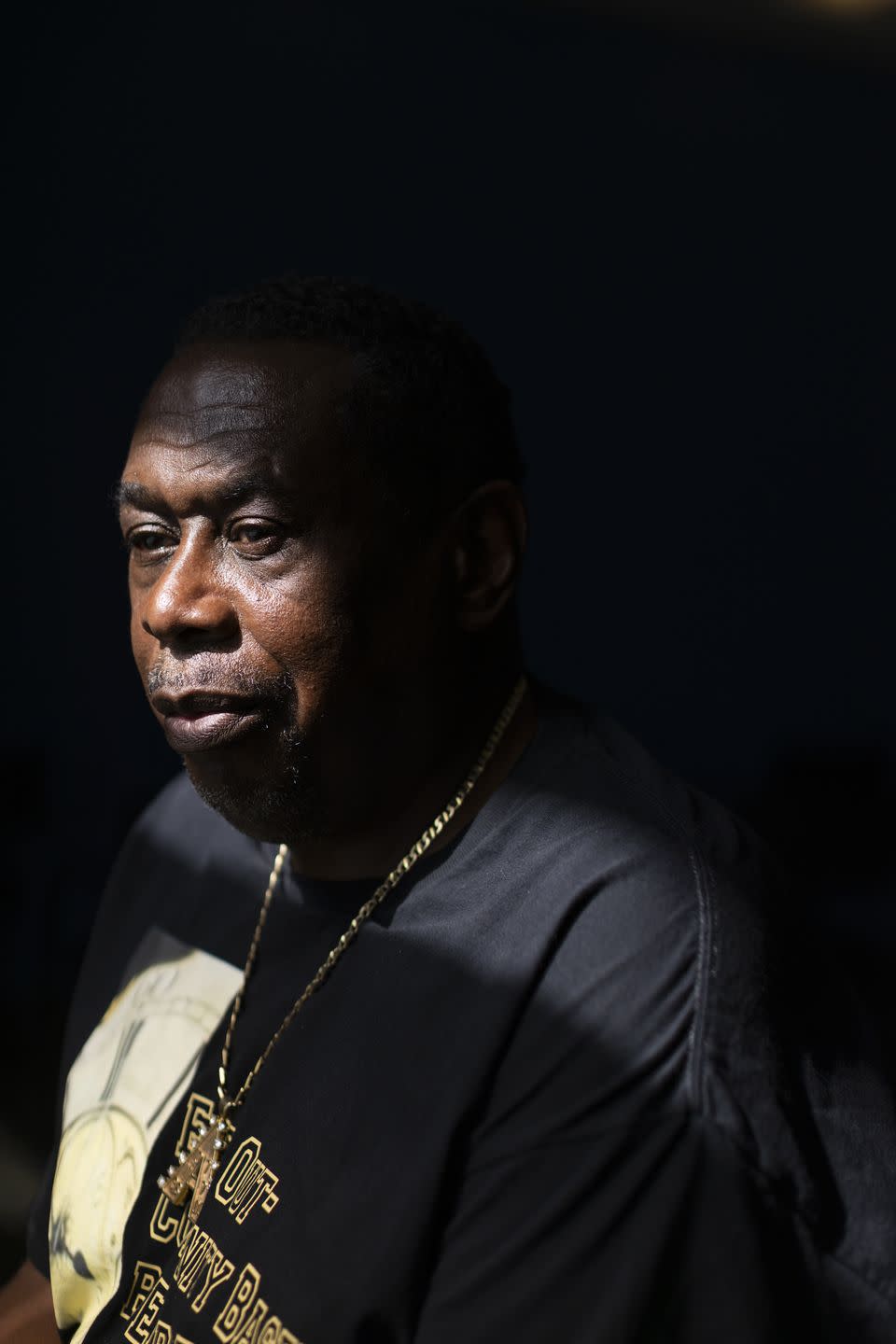
Larry runs the Fresh Out Community Based Re-Entry Program, which helps people in prison transition to a life on the outside. He typically makes contact with someone two years before they’re scheduled for release, laying out the kind of resources he can offer them out in the world: mentoring from a peer with similar life experiences, assistance getting a job or their driver’s license back, even short-term help with rent or a car payment. He’s got good relationships with parole officers and helps his clients build them, too. His organization is part of two BHRNs (pronounced “burns”—more on that in a minute), and while Fresh Out doesn’t do substance-abuse treatment, he’s got contacts in other organizations that do. He’s got a day job with the county, but Fresh Out doesn’t have an office. Larry and his volunteer staff go into penitentiaries and convince people there’s a community on the outside they can depend on, one that’s wholly separate from the situation they were in before they went in.
The organization gets some of its funding through Measure 110, money that was earmarked for drug treatment but also for organizations that are attempting to rebuild the Black, brown, and Indigenous communities disproportionately affected by the drug war. That $300 million took a year and a half to arrive, though, and that’s a year and a half longer than it took for the other side of Measure 110 to take effect: the decriminalization.
That’s the side that’s been getting the headlines, because there’s no sense beating around it: Downtown Portland is a shit show, and not just because I walked by a guy as he dropped trousers and squatted around 8:00 A.M. on a Wednesday morning. There are lone tents pitched on the curb on many blocks, others in groups of five or six, and people all around with tarps and sleeping bags and camping gear. Local businesses have hired private security to patrol in the evenings. Walking through downtown and nearby Old Town in the afternoon, it’s the same scene every other block: mostly clean streets lined with big old trees, nearly empty but for folks slumped up against buildings or standing precariously. And then there’s the metallic glint as someone manipulates a square of tinfoil with their fingers, a dark clump at its center, the click as a lighter is produced and raised to the tinfoil, now near chin level to meet a straw, all right on the sidewalk. It is a spectral scene, particularly in Old Town, watching people destroy themselves among the famous cast-iron facades of nineteenth-century buildings that remember a time when great American cities seemed to spring up out of the ground all over the place. To be fair, some people on this continent might have felt more like something was dropped on their heads.
A little while back, Portland police busted up an open-air fentanyl market downtown, two blocks from where Larry and I sat at the Vietnamese spot. He offered to take me, and we set off past the staircase, where a crowd had clustered tightly once again. I had to stop in my tracks at one point as a young white woman, no older than twenty-two or so, stepped in front of me to block a narrow section of the sidewalk. She raised a lighter to tinfoil as I stood not three feet away. It was as if nothing else existed in the world except the dark clump on those shimmering wrinkles of foil, nothing happening except what was about to happen, had to happen, fast, now.
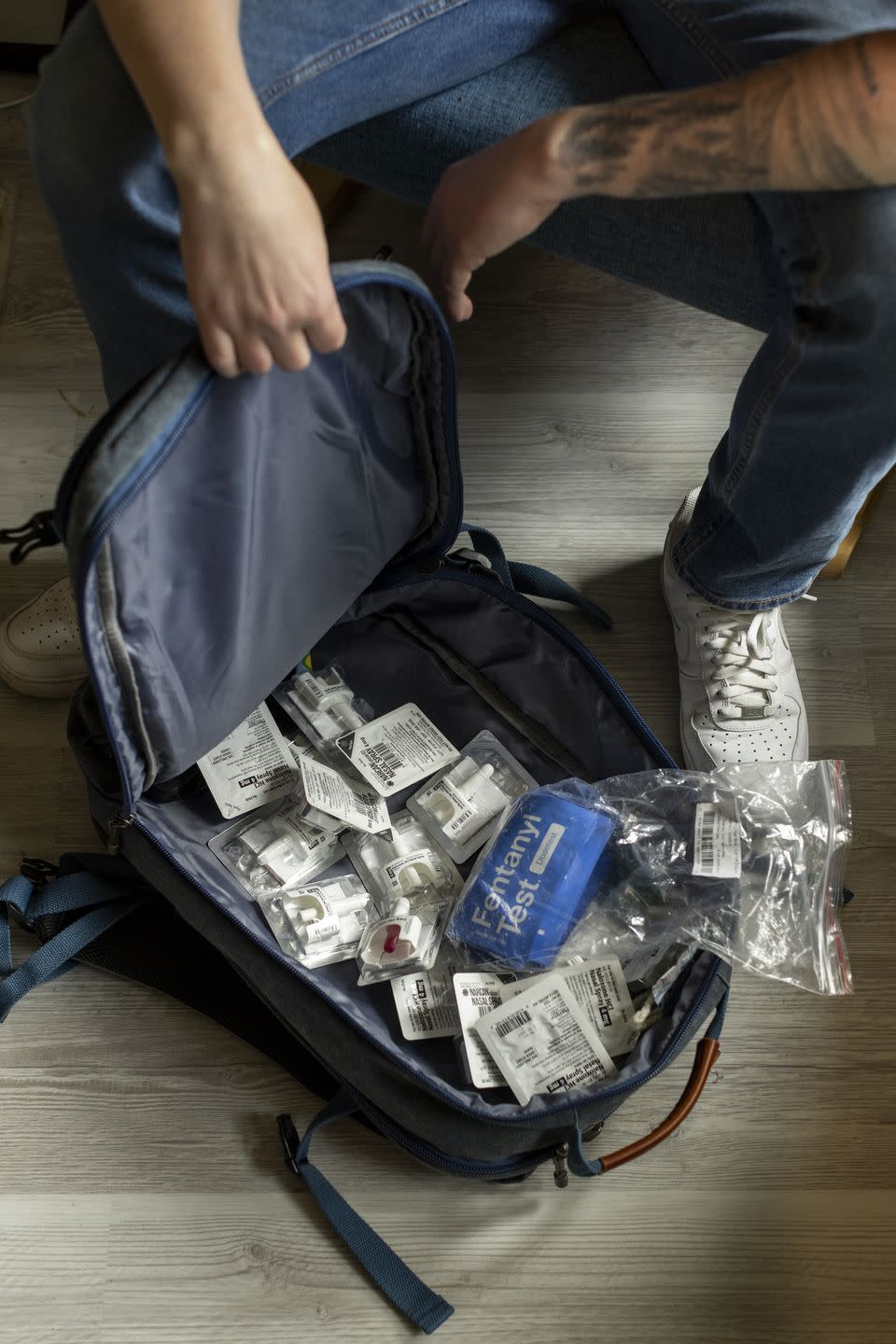
“The open-air drug market was here,” Larry said on the next block, pointing to a boarded-up building across the street. “Now it’s here,” he said, gesturing two blocks back to where the group had gathered around the staircase. We both had to chuckle. Police across Oregon have mostly slammed Measure 110, complaining it has hamstrung their ability to keep order on the streets. “It doesn’t look like the results reflect what was originally hoped for” with Measure 110, Portland police chief Chuck Lovell said in a statement, though he added this wasn’t an indictment of treating substance use as a public-health issue as opposed to a criminal one. It was more a case, he said, of making “adjustments.” The law instructs cops to issue a hundred-dollar citation for simple possession that people can then waive by calling a hotline, but the chief pointed out this pretty much never happens.
Most cops around Oregon aren’t writing the tickets in the first place, though, and besides, an ultimate goal of Measure 110 was to take police and the criminal-justice system out of the business of addressing drug use altogether. (Property crimes like burglary and vandalism are still very much illegal, to be clear, even if cases have skyrocketed and they’re rarely cleared. Trafficking has not been decriminalized either, though a black market means suppliers settle their differences with violent force.)
Now drug users don’t catch felonies that harm their future employment and housing prospects. The traditional model—arrest people, threaten them with prison if they don’t go to drug court, and thereby force them into treatment—works for some people, though its effectiveness varies widely depending on the place and the program. And where do we draw the finish line? Six months sober? A year? And how do we make sure people keep on running after we call the race?
Ask the people doing their smaller experiments within the broader one of Measure 110 and they’ll tell you that for many people struggling with drug use, it’s not about twelve steps or doctors in lab coats or paperwork. We’ve made progress on treating drug abuse as a health issue, but for many people it’s about creating a less medicalized—less formal—approach. It’s about a sandwich or a couch where you can watch football on a Sunday, about building a little community for people to live inside. It’s about stabilizing people long enough that you can start to deal with the traumatic wounds that often lie beneath a layer of powder and pills. The solution is as hard as the work is. There’s no quick fix, because it never really ends, and yet they’re just asking for some time—more than America’s politicians and voting public like to give anything—to try something new.
And if it doesn’t work? “We can always go back to what wasn’t working before,” Larry said.
The BHRNs of which Fresh Out is a part are behavioral-health resource networks, a piece of Measure 110 that’s nearly as important as the legal-weed money. There’s now at least one in every Oregon county, a web of aid groups that provide “wraparound” services to anyone who comes to any one of them for help. Not every organization can do everything, but in theory, every BHRN can. Take, for instance, the case of Columbia Community Mental Health.
Across the Columbia River from Mount St. Helens, the stratovolcano that blew its top forty-three years ago in the worst such disaster in U.S. history, there’s a town about forty minutes from Portland that took its name. At fourteen thousand people, St. Helens is the Columbia County seat, and it’s where Miriam Parker and Candi Balabon help run CCMH from an office-park-ish structure on Route 30. A key part of their approach is medication-assisted therapy (MAT), and that’s where the BHRNs come in. Methadone is the best-known medication for treatment, but it’s highly regulated and usually involves frequent visits to a clinic. Like most places outside Portland, there are no methadone centers in St. Helens. The more common prescriptions for treating opioid use out here are for suboxone or buprenorphine. (There is no established medication for treating meth dependence.) While CCMH doesn’t get people on suboxone, they do share a BHRN with an organization that does.
When I visited the exposed-brick offices of Boulder Care in a landmarked Italianate-style building just off the Willamette River in Portland, three dogs were roaming around the lofty open-plan workplace. The group uses telehealth services to get people medication for their opioid-use disorders quickly, with lower barriers to entry than in-person treatment. With the short window in which many folks are open to starting therapy, speed is vital.
In a glass-walled meeting room upstairs, her tiny dog occasionally scratching at the door, Justine—yes, the same one who met Brandon, Damon, and Red, now at her day job—walked me through how they’ve assembled many of the services that other organizations have put under a physical roof in a single app: doctors, peers, case managers. Even before the funding came in from Measure 110, they were already operating all over the state, but they used the new system to get set up in BHRNs across eight counties and expand their services. It’s given them the broadest reach of any organization so far.
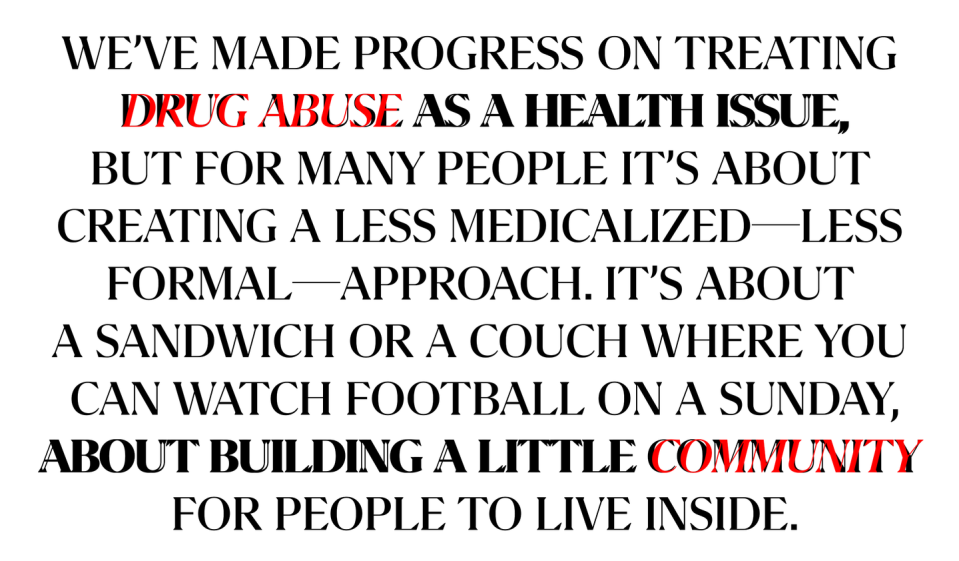
When Candi and Miriam take someone on, they’ll often take them to Walmart and get them a cheap smartphone if they don’t have one. It’s not just to stay in communication with their peer mentors. It’s the key, in some cases, to their treatment, and they set up the Boulder Care app on the device before they hand it over. Medication, whether suboxone or methadone, can stabilize someone and stop the desperate cycle of getting high and running from withdrawal. It’s the terror of dope sickness that often leads people to break into cars to steal shit they can sell.
Like Larry Turner and his team, Candi and hers go into prisons before people are released in order to make contact and develop a treatment plan. But out on the street, the first step is usually something small: a water, a sandwich, a shower, a haircut. “That person’s probably not going to [immediately] say, ‘Can you take me to treatment?’” Candi said, chuckling. “But then we start talking and sharing our experience. Do you really want something different than this, or is this what you want to do? Because we can help you with a tent tarp and a sleeping bag.”
Candi and her team of peer mentors speak from experience. She did meth for decades, and of the three prison stints she served, twenty-eight months were for simple possession. “A little bag that the dope had been dumped out of,” she said, “and now I’m a felon. Honestly, I was like, I’m going to do what I got to do. I got to get out and survive. So who do I contact while I’m in there? Not the good people.” She laughed. “Where do I go? Right to the dope man.”
The low-barrier medication-assisted therapy that Boulder Care offers is on the less regimented side of things, the other end of the spectrum from traditional inpatient therapy. Between them is “intensive outpatient with housing,” like what the Oregon Change Clinic has set up south of downtown Portland at what used to be the Sixth Avenue Motel. The reviews are still there on Google: filthy carpets and bedding and towels, bed bugs, broken appliances. Shannon Jones, CEO and founder of the OCC, showed me photos of one of the rooms that caught fire and was left as a burned-out husk. Rooms went by the hour, attracting a certain clientele, which made her that much more uncomfortable when she put people up there who were in desperate need of housing.
When the Measure 110 funds came in, she used some of the money granted to her organization to take control of the whole building, repaint, and remodel. Now she calls it “the Barracks,” a nod to her years in the Marines. Some folks are on MAT here, others aren’t, but everyone’s expected to follow the rules.
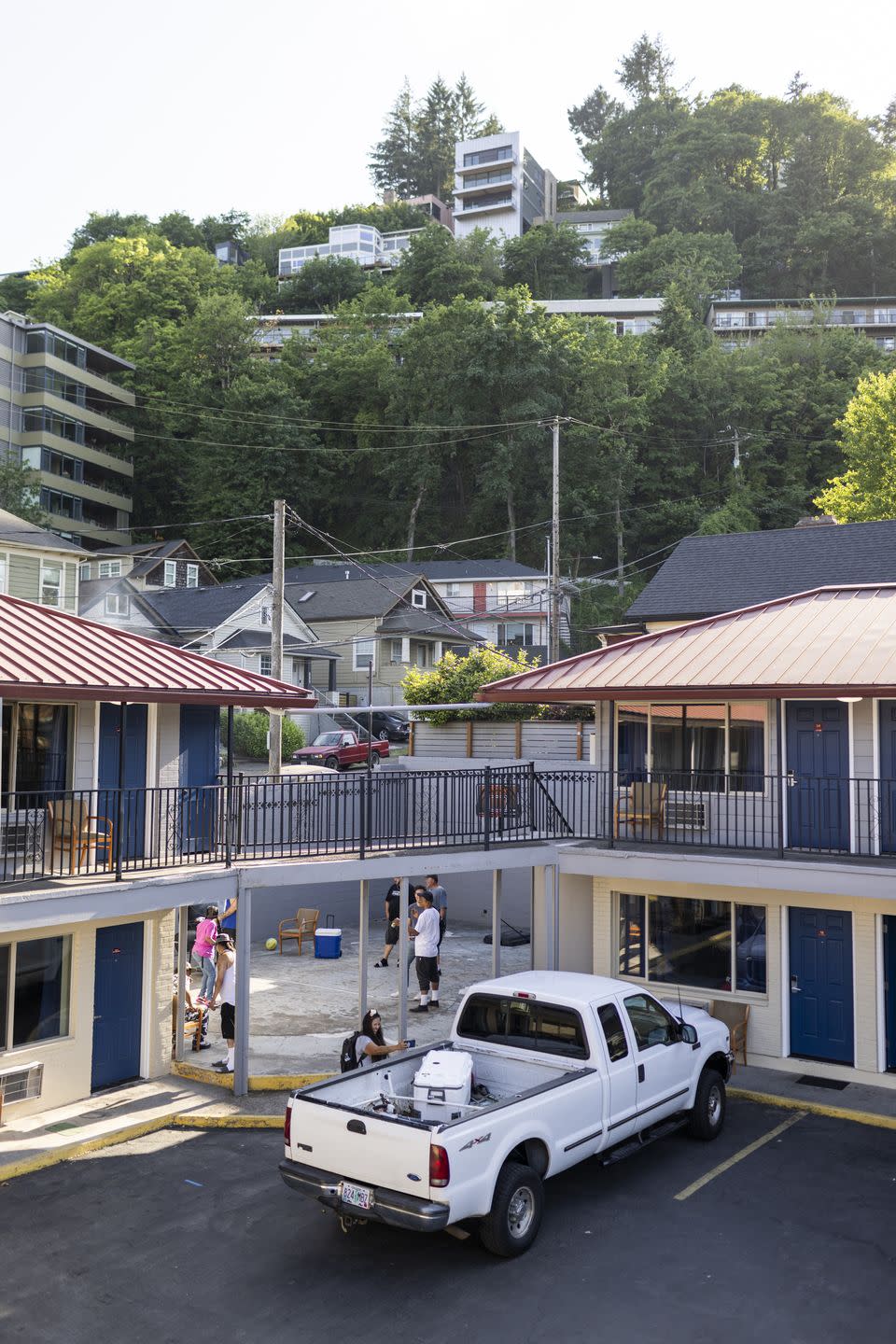
“This place saved my life, man,” Sergio Stephens told me. He was walking through the parking lot when I arrived. He had on a Golden State Warriors hat and a big blue shirt that was oversize even on his towering frame. He’d come up from Medford, down near Oregon’s border with California, to chase a girl before it all went wrong. Even before that, Sergio struggled with depression. But every time he reached out to doctors for help, “they just looked at me like I’m stupid, and I hate that.” They made him feel like he was “in the way,” so he said fuck it. “I’d smoke white”—meaning meth—“just to clean my room or something, to take my mind off it,” he said.
One night, he was walking down the freeway wearing dark clothes, thinking he could just “take three steps to the left” and throw himself in front of a semitruck. Eventually the ex-girlfriend dropped him off at Hooper, one of the detox facilities around town, where they started him on some new medication and he got hooked up with the Oregon Change Clinic.
Want more stories like this? Become an Esquire subscriber today.
subscribe
“Yo-Yo here is the mama I never had,” he said, smiling toward Yolanda Jackson, who supervises the motel residents from an office on the first floor. She really is something like a den mother around here, giggly and nurturing but not someone you’d want to cross. She does room inspections and enforces curfews. Unlike at most inpatient facilities, the residents here are free to go out into the city, but you better be back on time. The longer you’re there, the longer you’re not using, the later your curfew. Shannon says she used to be able to put people up for three months, but 110 funding has allowed her to extend it to six. Ideally, she says, it would be for the better part of a year.
The intensive-outpatient model she’s designed is highly structured, but it’s not the 24/7 insulated environment of traditional inpatient. Brandon told me the latter isn’t always useful, because it can be like another planet, removed from the real life you return to when twenty-eight or sixty days are up. The participants here are free to go out into the city and test themselves against its temptations. When I left on Tuesday evening, Sergio was headed down to the water to see the ships come in for Portland’s Fleet Week. He wanted to be back in time for Taco Tuesday at the Barracks.
“One thing about being on the street is,” Larry said, kissing his teeth to clear some remnant Vietnamese fare, “never say you’ll do something you can’t do. That’s how you build relationships.” We were going to his car to get some Narcan he’d promised folks outside the restaurant. We came across another group on the next block, two women and a man who looked about fifty. There were clothes and blankets and boxes and containers strewn about, the markings of an outdoor living room. One of the women was hunched over, sitting on her heels, with a tinfoil square near her face and a straw at the ready. Larry told them there was some bad shit going around and he didn’t want to see anyone dying out here. The man said he wasn’t going to die.
“Okay,” Larry said when we’d walked away. “There’s motherfuckers that been dead that was talkin’ that shit. Like he’s a fuckin’ chemist or something.”
As we walked, Larry recited the statistics on median household income. “$24,000 for Blacks,” he said. “$189,000 for whites. Asians are second with $74,000. Latinos get 36.” (A recent census report found $14,000, $187,000, $206,000, and $32,000, respectively.) Larry greeted a couple guys crossing the street against us, clearly into some shit but mobile. He traced the organized racial terror of the post-Reconstruction period and the free rein white Americans had to destroy Black wealth for decades. Despite its newfound reputation as a bastion of pie-sky liberalism, Oregon is no historical exception. Larry recounted how white settlers were offered six hundred acres of land to come here back in the 1850s, whereas Black people were punished—at first with a public whipping, later changed to forced labor—if they stayed longer than six months. “They were taken to Pioneer Square, right up there and given twenty lashes.”
He was referring to one of the core landmarks of Portland’s city center, which these days is no Piccadilly Circus. As a resident of an often catastrophized big city, though, I should be clear that Portland is not some postapocalyptic hellhole. Next door to downtown, the Pearl District is leafy streets and microbreweries and well-off white women toting yoga mats, the Portland on the brochure. Across the river, on Southeast Division, funky fusion restaurants neighbor new-build condos. Like anywhere, the tony precincts seem to employ a kind of force field to keep the suffering out of sight.
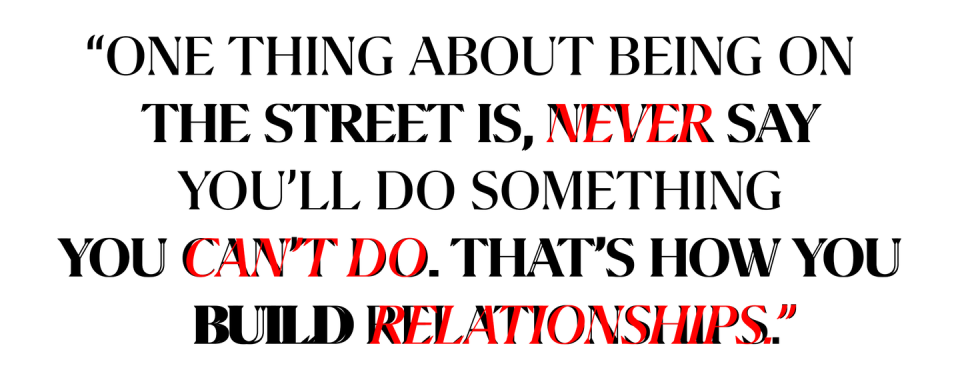
Larry and I rounded a corner and eventually arrived at his white sedan, parked just off the Morrison Bridge, one of twelve that cross the Willamette River here in “Bridgetown.” Two more span the Columbia River to the north. Back at the restaurant, Larry had mentioned the state’s plans to build a new bridge that at current estimates will cost $6 billion, twenty times what Measure 110 has distributed. Later, he told me he’d warned the mayor back in 2000 that they had to tackle drug use or they’d face a crisis, “but nobody wanted to hear it. They wanted to build bike lanes. They wanted to have the dog parks. So they invested the money in that.”
To cut down on open consumption on the sidewalk, Larry’s in favor of safe-use sites like those you’ll find in Portugal or Switzerland, but those countries arguably have more punitive tools to push people out of their use cycles than Oregon does. As Larry popped open his trunk, I asked whether he thought Oregon might need more stick in addition to the carrot. He sighed, opening up a cardboard box to fish around for some Narcan. “That’s a tough question. Because when you’re dealing with a system where no matter what you plug into it, you’re going to get the same outcome—which is racist results—then my people are going to suffer.”
“Definitely I would like to see some kind of mechanism where people could be challenged to make some changes in their life,” he said, but it matters who gets to decide how that’s done. Larry’s style is to make a connection and then cajole, annoy, persist. He’s not one to hand someone a tarp. Folks who do are “actually supporting and promoting homelessness,” he said. He believes in harm reduction of a kind, but he considers the tent stuff to be white people shit. He thinks you’ve got to get someone four walls and a steady job.
Everybody in this field has their own ways to navigate the philosophical quandaries, and nobody getting money through Measure 110 is pretending they have all the answers. Is the solution “housing first,” even before somebody gets sober, or do you give people medication and the supplies to keep living on the streets, hoping they can get clean in a tent? And considering all the many years when patients—especially Black patients—were thrown out of traditional inpatient programs so hastily, how do you decide when and why to toss somebody for screwing up?
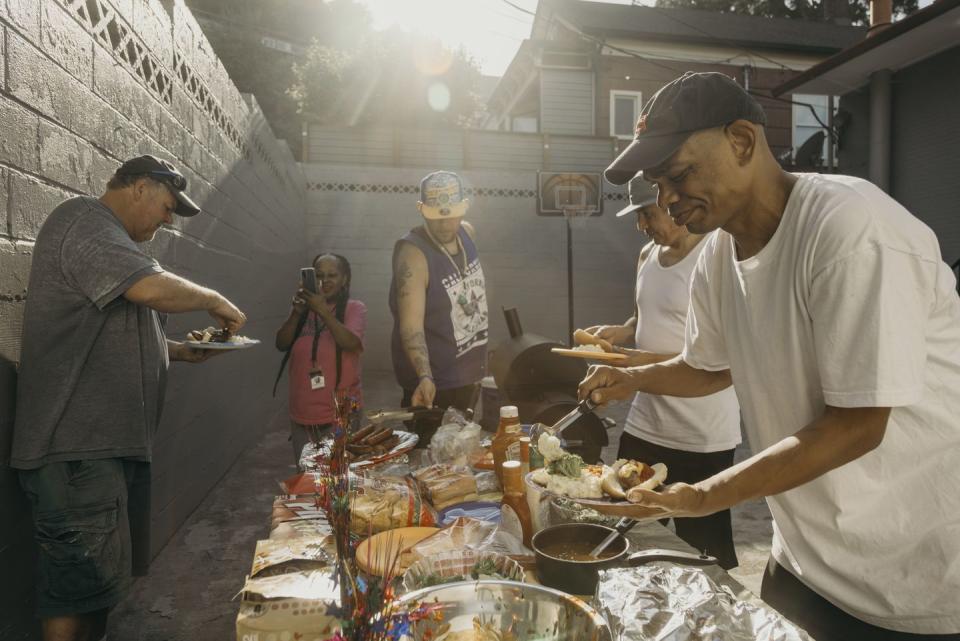
Fresh Out shares a BHRN with the Oregon Change Clinic and also with the Miracles Club, where Larry took me to meet some of his success stories. The clinic is at the foot of a high-rise in which Miracles has more than forty units of housing for people in need, and it’s in the process of trying to buy the whole building. The group doesn’t do drug treatment, but it secured some Measure 110 funds to continue its work in mentoring, getting people housed, and just giving Black people who are struggling a place to talk and eat and not be alone. Miracles reports that it’s served more than six thousand people with the funds it’s received.
At the front desk, Larry introduced me to Jamaul Jenkins, a mountain of a man with long black hair and purplish-tinted glasses. “I don’t do a lot of standin’ no more,” he said when it was time to pose for a photo with Larry, who brought him into the Fresh Out program when Jamaul was still in prison. Now he’s been a certified recovery mentor—CRM—at Miracles for three years. He’s got dozens of clients. Fresh Out helped him get his driver’s license back when he was released, and Larry’s helped others get commercial trucking licenses. A couple have been certified as electricians, and everybody comes back to the group meetings every Thursday. At one point, I made the mistake of asking Jamaul how long he was with Fresh Out, and Larry interjected. “He’s still with Fresh Out,” he said. “You never graduate.”
Jamaul introduced me to Tamiko, one of his early mentees who is now a CRM herself. This is one of the ways that folks pay it forward, creating webs of people who’ve been helped and help others. Larry started paying it forward twenty-six years ago, when he got out of prison after multiple stints for possession of a crack pipe and one for robbery. As he stood in the light coming through a slat of the converted garage door behind him, the sound of bustling traffic blaring in from Martin Luther King Jr. Boulevard outside, he said that fentanyl is now what crack once was around here. “They had the National Guard over here, with the M16’s walking down the street,” he said, gesturing outside. “They had the helicopters.” He said some people might have gotten screwed over in St. Helens, where I told him I’d visited earlier that day, but they didn’t have that.
Larry will always remind you of the restorative-justice aims of Measure 110, and he makes no bones about the fact that he is in this to stabilize Black people’s lives so that they can begin to build Black wealth. He is a member, with Shannon and Michael and others, of OBBIAC—the Oregon Black Brown Indigenous Advocacy Coalition—which convenes every other week with the intent to hold each other accountable for using 110 funds correctly and to make sure the “big-box white organizations” who’ve gotten funding do the same. These leaders say those are the places that have never been able to provide adequate services to Black and brown Oregonians. Many of the people who need help distrust doctors and any kind of institutional environment nearly as much as they distrust the cops. So the folks in this circle refer clients to one another not by giving them the name of an organization and a bunch of paperwork but a name and a face and an assurance. You trust me? You can trust Larry.
At Morgan’s skinny two-story apartment in Southeast Portland, there were boxes of Narcan and other opioid interrupters all over the place, many of which had been donated by pharmaceutical companies. She settled into a chair near some plants at her window so we could take her picture. We’d come early so as not to disturb her during a meeting of Measure 110’s Oversight and Accountability Council, a group charged with distributing the 110 funds and making sure they aren’t wasted. Morgan said there hadn’t been nearly enough clarity or support from the Oregon Health Authority, a complaint I’d also heard from Miriam up in St. Helens. The Oregon legislature passed a bill in June to bring the OHA into a more formalized role administering 110.
“What Measure 110 is asking us to do is a huge shift in thinking and in approach,” Miriam said. “We’re not going to see outcomes on a community level, county level, state level in six months or twelve months. They want to see numbers, big numbers. They want to see hard data. We want that, too, but it just is going to take time. So I’m worried that politicians won’t necessarily give us the time that we need to show those outcomes. I hope they don’t give up on this project.”
This is difficult work, even when you’re paid a fair wage, even when you feel, as these folks do, that every human being is worth it. It can be heartbreaking. Before we left her house, Morgan told me that Brandon hadn’t shown up that morning. She’d stopped hearing from him around 8:00 P.M. the previous night. Maybe he’d just been unable to charge his phone out on the street. Maybe.
“I seen the big-ass turret guns on it,” Sergio said when I asked him about the boats he’d gone to see the day before, wheeling his arms around to mimic a deck gunner. Soon he was working some brats on the grill. The loitering evening sun of the Northwest summer beamed down on the concrete courtyard while the spangled guitar of a classic-rock playlist bumped out of a speaker on the ground. The spread next to the grill grew into a feast as Yolanda cooked up some sides in the kitchen of the rec area, where a few guys were watching the NBA Finals.
Yolanda introduced me to Andrew MacTaggart, a motel resident with a room on the first floor, and when I told him this story was about Measure 110, he started rattling off statistics about the program’s unspent funds. He said he’d done inpatient treatment for alcohol years ago and gotten into meth sometime after he got out, at first dosing some into his morning coffee in what he told himself for years was a manageable arrangement. “I probably had a bunch of fuckin’ psychotic episodes that I didn’t know about,” he admits now. But he’d finagled a two-bedroom apartment that he got rental assistance on until he reached the point where he was “too fuckin’ high to pick up the phone when the rental assistance [people] called.”

He was living on the streets by the time he showed up outside the Miracles Club. They struggled to find him anything and told him to come back after the weekend. “I’m like, ‘What! I have nowhere to go, I’ve just been sober for like two days, I love meth and shit, and you’re telling me to come back in three days?”
He did it, and he made it here to the motel, where he’s got some thoughts on what really ails his hometown. “Portland finally grew up. We’ve always been [somewhere] between a big town and a small city, and now there’s an element of danger. It’s not fun out there anymore.” Still, Oregon is trying something new. “I like the analogy of, you’re cleaning your room,” he said. “You could kick everything under the bed, hide shit, and make it look clean for the photo shoot. Or you could really clean the fuckin’ room, and halfway through it looks way dirtier than when it started. I think that’s where we’re at.”
Maybe, at the end of all this, Portland will still be a mess. It’s certainly a mess right now, two and a half years since Measure 110 decriminalized drugs and ten months after that legal-weed money went out. The people making use of it are asking for some time. Getting clean—really clean—often takes more than six months or twelve steps. At least that’s what the people doing the work say. If they’re wrong, Oregon can always go back to kicking shit under the bed.
You Might Also Like

